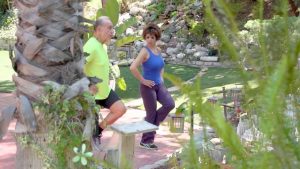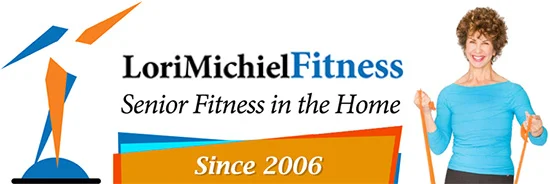Balance: Stay Vertical – Resist the Hidden Danger of Falling
Even in your 30s and 40s, specific exercises can help prevent a big danger that can be a part of aging.
You know it when you feel it
If you find yourself needing to sit down to take off your shoes, it might be time to start paying attention to your sense of balance.
People don’t usually think about balance until they fall or trip or know someone they never thought would. There are signs that cannot be ignored such as holding onto hand rails to go up and down the stairs, wavering as you step into a pair of pants, missing the lip on a curb. These situations can be an early warning sign that your stability is starting to decline.
Once recognized, it is important not to dismiss the signs because loss of balance is usually treatable, but will often get worse if ignored. A formal assessment can indicate balance issues, but does help predict the chances of becoming “one with the floor”.
Hidden dangers if we ignore our balance
We lose the equivalent of seven pounds of our muscle strength each decade from early adulthood on, if no action is taken.
- By age 60 we have lost 30%
- By age 70 we have lost 45%
- By age 80 we have lost 60%
The research into falls, fall risk and fall prevention is extensive because falls are the leading cause of injuries in adults over age 65 according to the Centers for Disease Control and Prevention. Every 17 seconds, someone in this age group is treated in an emergency room for a fall. Every 30 minutes, someone will die from their injury. Two-thirds of those who fall will do so again within six months without intervention.
Weak muscles, which support joints, and weak bones, are compromised. After six months following a fall, only 15% of people are able to walk across the room unaided. Assisted devices become a new companion and relocation to an assisted living community becomes the new reality.
 What couldn’t you do today that you were able to do a year ago?
What couldn’t you do today that you were able to do a year ago?
A friend in her fifties recently told me when she went fishing a year ago and she was fearless when walking across a log laid over a stream in the woods. This year, she instinctively knew she would fall into the stream if she tried to cross on that same log; her balance had deteriorated that much in just a year’s time.
Is your stability in danger? Take our Balance Profile Quiz and get the answers.
Muscle groups and other causes of imbalance
-
- Poor postural muscles
- Tight hip flexors when sitting too long affects gait
- Tight hamstrings which can lead to back pain
- Decreased sensation in legs and feet
- Vision impairment
- Dizziness or vertigo
- Medications
- Various neurological conditions
What Do the Experts Say?
Specific recommendations are done after a formal evaluation is performed. Only functional, evidence-based tests are used such as the Functional Fitness Test, Berg Balance Scale, Fullerton Advanced Balance Scale, Dynamic Gait Index, Timed Up and Go Test, Tinetti Balance Test and more. Clients are tested with and without footwear, and with and without assisted devices, when appropriate. The recommendations from 2010 guidelines still hold those specific programs for treatment. They must include multi-positional balance, gait and strength training, such as tai chi, physical therapy or personal training with a certified professional.
What’s Next?
Careful interpretation of evaluation results can provide a meaningful basis for developing a fitness plan that meets an individual’s short and long-term goals for functional mobility. With the right toolbox, clients can learn how to target and re-train certain muscles, transfer weight, improve motor control, balance, coordination, synchronization of muscle groups and neuromotor control.
Read more about Lori Michiel Fitness’ Exer-tasking techniques for balance. Check out our Exercise Snack Videos for exercises you can do at home to assist you with your balance.
It All Begins With a Consultation with Lori
Sources:
Laurence Z. Rubenstein: Falls in Older People: epidemiology, risk factors, and strategies for prevention. Age and Ageing: 2006
Kenneth C. Howayeck D.P.M: BONE Health Made Easy (2006)
Zecevic AA et al. (2006). Defining a fall and reasons for falling: Comparisons among the views of seniors, health care providers, and the research literature. The Gerontologist, 46:367-376.
Blake A et al.(1988). Falls by elderly people at home: prevalence and associated factors. Age and Ageing, 17:365-372.
Prudham D, Evans J (1981). Factors associated with falls in the elderly: a community study. Age and Ageing, 10:141-146. 4. Campbell AJ et al. (1981). Falls in old age
Tinetti ME, Speechley M, Ginter SF (1988). Risk factors for falls among elderly persons living in the community. New England Journal of Medicine, 319:1701-1707.
Pew Research Center
Gillespie LD, Robertson MC, Gillespie WJ et al. Interventions for preventing falls in older people living in the community. Cochrane Database System Rev 2012;9:CD007146.
Sherrington C, Whitney JC, Lord SR et al. Effective exercise for the prevention of falls: A systematic review and meta‐analysis. Journal of American Geriatric Society 2008; 56:2234–2243.
Panel on Prevention of Falls in Older Persons. American Geriatrics Society and British Geriatrics Society. Summary of the Updated American Geriatrics Society/British Geriatrics Society clinical practice guideline for prevention of falls in older persons. Journal of American Geriatric Society 2011; 59:148–157.
Avin KG, Hanke TA, Kirk‐Sanchez N et al. Management of falls in community‐dwelling older adults: Clinical Guidance Statement from the Academy of Geriatric Physical Therapy of the American Physical Therapy Association. Physical Therapy 2015; 95:815–834.
National Institute for Health and Care Excellence. Falls assessment and prevention of falls in older persons. NICE Clinical Guideline 161, Available Access April 1, 2015 http://www.nice.org.uk/CG161
